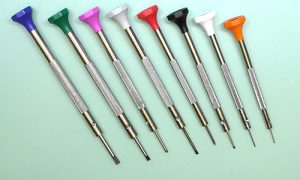The ability to record intervals of time independently of the running of a mechanical watch, is made possible with the inclusion of a chronograph complication.
A chronograph complication allows the user to start and stop a sub train of wheels within a watch movement. It will record the elapsed time between the start and stop very accurately and this elapsed time will be displayed to the user by means of additional watch dial indicators.
When the user has finished recording the time elapsed they are able to either reset the chronograph to zero, or with most chronograph complications, will have the ability to resume recording until they decide to perform a final stop and reset.
All of this can be achieved without affecting the regular function of the watch movement as it continues to keep time.
With most chronograph watches, the user will be able to operate the mechanism by the use of two pushers inset within the watch case.
The user engages or disengages the chronograph by depressing the start/stop pusher which will connect the chronograph train of wheels to the main gear train of the watch movement.
When the chronograph train is disengaged the second pusher can be used to reset the chronograph train to it’s zero position and the train will stay in this position until the mechanism is started again.
We have learned that with calendar and automatic mechanisms you will find different manufacturers have made tweaks to design and method of operation in order to either cut costs, or increase performance and you will find the same to be true with chronograph mechanisms.
But as with calendar and automatic mechanisms, these tweaks and design differences do not change the basic principles of operation, so as you come to inspect and work on many different calibres, you will find that many chronographs work in the same manner with some exceptions.
There are two main methods with chronograph mechanisms when it comes to the start/stop operation and in particular, how the start and stop is achieved.
The Pillar Wheel method
The cam method
But to start with we shall take a look at the chronograph complication in general terms, and discuss the series of events which takes place when a user engages, disengages and resets the mechanism.
We shall then continue and strip the chronograph mechanism down to it’s individual components and discuss how those parts interact with each other in detail.
To illustrate this we shall be using a very popular movement found in many vintage chronograph watches, the Venus 175. In fact, we will be using a much more reasonably priced Chinese clone of this movement made by Seagull which is Caliber ST1903. This movement can be found quite easily either on eBay, AliExpress and it is sold by CousinsUK under the product code: CH1903M




4 comments
Colditz
Hi
I am having problems with the video 4.3. It loads extremely slow and cuts from time to time./ Explorer sometimes reports it cannot find the video file. Is anyone else having this problem?
Thanks
Mark Lovick
Hi Steve, all tested fine here, did you try adjusting the resolution? Videos are available in 1080p down to 540p and stream quality will depend on your ISP and it’s connection to the nearest Vimeo cloud server.
Having said that, I am experimenting with Amazon Cloud at the moment (aparently the same service Netflix uses). I have changed try now and let me know if it’s any better for you.
Colditz
Hi Mark
Thank you for checking.
I was running under Explorer 11 and this seems to be the problem.
I did try Fire Fox and got the same issue, very slow to download content.
I installed Google Chrome and all seems okay under Chrome.
I hope if someone else is experiencing a really slow download issue, this helps.
Regards Steve
Mark Lovick
That’s good to know and thank you for sharing your solution